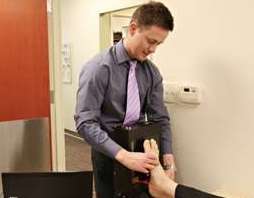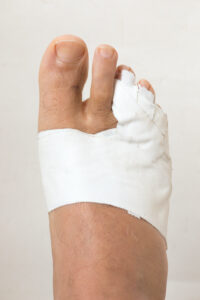
Summer is the season of sunshine, sandals, and unfortunately—stubbed toes. With outdoor activities in full swing and footwear choices shifting to flip-flops and bare feet, it’s no surprise that toe injuries spike during the warmer months. Whether you’re chasing your dog across the backyard, stubbing your toe on patio furniture, or misjudging the corner of a poolside lounge chair, summer foot trauma is all too common.
But when that sharp pain hits, how do you know if your toe is jammed, stubbed, or broken? And what should you do next? At Kansas City Foot Specialists in Overland Park, we see it all—and we’re here to help you make sense of your symptoms and get back on your feet.
Why Summer Is Prime Time for Toe Injuries
During the summer, people are more active outdoors, often wearing less protective footwear or going barefoot. While flip-flops and sandals may be comfortable in the heat, they offer little protection from bumps, drops, or awkward landings. And if you’ve ever sprinted barefoot across a hot driveway or tripped on a sprinkler head, you know just how vulnerable your toes can be.
From backyard barbecues to beach vacations, your feet are exposed to a host of hazards that can lead to toe injuries. Common culprits include:
- Walking barefoot on hard or uneven surfaces
- Kicking furniture or sports equipment
- Tripping over garden tools, hoses, or toys
- Impact from falling objects like coolers or lawn chairs
- Overuse from summer sports like soccer, running, or hiking
While some injuries may be minor, others require medical attention—and knowing the difference can make all the difference.
Stubbed, Jammed, or Broken?
While these injuries may feel similar at first, understanding the difference is key for proper care and recovery.
Stubbed Toe
A stubbed toe happens when your toe forcefully collides with a solid object—think furniture leg, pool step, or concrete edge. The trauma is typically external, impacting the soft tissue, skin, and nail bed.
Symptoms of a Stubbed Toe:
- Immediate sharp pain
- Swelling or bruising
- Redness and tenderness
- Pain that fades over a few hours or days
- Possible minor cuts or nail damage
Jammed Toe
A jammed toe involves trauma to the joint, usually caused by impact that forces the toe beyond its normal range of motion. This often affects ligaments or cartilage.
Symptoms of a Jammed Toe:
- Deep, aching joint pain
- Swelling and stiffness
- Difficulty bending or moving the toe
- A sensation of “pressure” within the joint
- Mild bruising
Broken Toe
A broken toe occurs when one of the bones in the toe cracks or fractures. This may result from a direct blow (like dropping a heavy object on your foot) or severe stubbing/jamming.
Symptoms of a Broken Toe:
- Intense, lasting pain
- Immediate swelling and bruising
- Inability to move or put weight on the toe
- Deformity (crooked appearance)
- A “crack” sound at the time of injury
Diagnosing Toe Injuries – Is It More Than Just a Stub?
At first, it can be hard to tell if your toe is just bruised or seriously injured. Mild stubbed or jammed toes often improve with basic home care, while broken toes require professional diagnosis and treatment.
Here’s how Kansas City Foot Specialists helps determine the severity of a toe injury:

Physical Examination
Your podiatrist will evaluate the toe for signs of swelling, deformity, tenderness, and range of motion.
X-rays
 An X-ray is the most reliable way to determine if a toe is broken or simply jammed. Our in-office imaging makes diagnosis quick and convenient.
An X-ray is the most reliable way to determine if a toe is broken or simply jammed. Our in-office imaging makes diagnosis quick and convenient.
Injury History
Knowing how the injury happened gives valuable clues. A high-impact blow or inability to bear weight increases the likelihood of a fracture.
Treatment for Stubbed and Jammed Toes
Home Care Tips:
- R.I.C.E. (Rest, Ice, Compression, Elevation)
- Over-the-counter pain relief (acetaminophen or ibuprofen)
- Buddy taping to support the injured toe with a healthy neighbor
- Avoidance of tight or constrictive shoes
If pain or swelling persists beyond a few days, it’s time to seek professional care to rule out a fracture or ligament damage.
When to See a Foot Specialist
Don’t wait it out if you’re dealing with:
- Persistent toe pain that lasts more than a few days
- Swelling that doesn’t go down
- Bruising that spreads or deepens
- Visible deformity (toe looks crooked or out of place)
- Difficulty walking or bearing weight
- Signs of infection, like warmth, redness, or discharge from an open wound
Early diagnosis and treatment are critical, especially for broken toes. Left untreated, a fracture can lead to long-term complications such as chronic pain, stiffness, arthritis, or deformity.
Treating Broken Toes – What to Expect and How to Heal Properly
If you’ve been diagnosed with a broken toe, don’t panic. Most fractures heal well with the right care, but knowing what to expect can ease your recovery.
Common Treatments for Broken Toes:

- Walking Boot: A medical walking boot may be prescribed to stabilize and protect the toe while walking.
- Rest and Activity Modification: Avoid putting pressure on the toe. Crutches may be recommended in more severe cases.
- Pain Management: Over-the-counter medications or prescribed pain relievers.
- Surgery (if needed): Severe or displaced fractures may require surgical repair with pins, screws, or plates.
How Long Does a Broken Toe Take to Heal?
- Mild to moderate fractures: 4–6 weeks
- Severe fractures or surgical cases: 6–8 weeks or longer
- Follow-up visits: To monitor healing and adjust treatment as needed
Potential Complications of Untreated Broken Toes:
- Improper bone alignment
- Chronic pain or stiffness
- Joint arthritis
- Difficulty wearing shoes
- Ongoing balance or gait issues
Don’t risk long-term damage. The podiatrists at Kansas City Foot Specialists are highly experienced in diagnosing and treating toe fractures for optimal recovery.
Meet the Experts at Kansas City Foot Specialists
At Kansas City Foot Specialists in Overland Park, our team is committed to comprehensive, compassionate foot and ankle care. Whether your toe is jammed, stubbed, or broken, you can trust us to deliver accurate diagnoses and tailored treatment plans.
Dr. David Laha
 Dr. Laha brings decades of experience and advanced training in podiatric medicine and surgery. After earning his doctorate from a college of podiatric medicine, he completed a rigorous post-graduate residency and passed both state and national board exams. As a board-certified podiatric surgeon, Dr. Laha provides expert care for foot trauma, deformities, fractures, bunions, heel spurs, hammertoes, sprains, and more. His precision and personalized care approach are hallmarks of Kansas City Foot Specialists.
Dr. Laha brings decades of experience and advanced training in podiatric medicine and surgery. After earning his doctorate from a college of podiatric medicine, he completed a rigorous post-graduate residency and passed both state and national board exams. As a board-certified podiatric surgeon, Dr. Laha provides expert care for foot trauma, deformities, fractures, bunions, heel spurs, hammertoes, sprains, and more. His precision and personalized care approach are hallmarks of Kansas City Foot Specialists.
Dr. Andrew Hall
 Dr. Hall, a native of Dubuque, Iowa, is a skilled foot and ankle surgeon with a special interest in sports medicine, trauma, and limb preservation. He holds a Doctorate of Podiatric Medicine from Des Moines University and completed a three-year surgical residency at the Southern Arizona VA Medical Center. Dr. Hall is known for treating everything from minor forefoot injuries to complex ankle surgeries. He is board-qualified by the American Board of Foot and Ankle Surgery and actively involved in professional podiatric associations.
Dr. Hall, a native of Dubuque, Iowa, is a skilled foot and ankle surgeon with a special interest in sports medicine, trauma, and limb preservation. He holds a Doctorate of Podiatric Medicine from Des Moines University and completed a three-year surgical residency at the Southern Arizona VA Medical Center. Dr. Hall is known for treating everything from minor forefoot injuries to complex ankle surgeries. He is board-qualified by the American Board of Foot and Ankle Surgery and actively involved in professional podiatric associations.
Google Ratings of 4.6 Out of 5 Stars
With 4.6 stars out of 5, our Google reviews are the proof in the pudding when it comes to what our patients think:
“Dr. Laha has performed two toe surgeries on my feet….big toe on each foot. His expertise has given me excellent results. I have an artificial joint in each big toe and honestly forget they are there. I would send my family members to him.”
Carol S.
“Dr. Laha did a great job fixing my toe. Thoroughly explained everything to me. Made me feel very comfortable about procedure. Friendly and caring staff.”
Robyn L.
“I have had two procedures done by Dr. Laha; one was in his office with a reduction of my large toenails and the relief provided has been terrific. The other procedure was on December 19 in the Surgery Center which was a total joint replacement of both of my big toes and the relief from pain as a result of that surgery has been phenomenal. Dr. Laha and his staff are top notch. I have recommended him to my friends already. I wish I had learned of his services long ago. My feet and my life are focused on other things now like biking and hiking and everyday walking without the ever present pain.”
Danny H.
Our State-of-the-Art Surgery Center
When surgery is needed, your care doesn’t end with a diagnosis—it begins at our fully equipped, on-site Surgery Center of Blue Valley in Overland Park. As the only on-site podiatric surgery center in Kansas City, we offer:
- Convenience and continuity of care
- Advanced imaging and surgical technology
- Highly trained surgical staff
- Comfortable, modern recovery environment
- Expertise in both routine and complex foot and ankle procedures
Whether you’re dealing with a broken toe or in need of total foot reconstruction, Kansas City Foot Specialists “ensures the highest standard of care—without sending you to a hospital.
Don’t Ignore Toe Injuries
It might be tempting to “walk it off,” especially when summer fun is calling. But delaying care can lead to long-term damage that affects your mobility, comfort, and quality of life. Don’t risk improper bone alignment, arthritis in your toe joint, or chronic pain/stiffness. Make sure your toe heals properly with the correct treatment.
- Chronic pain or stiffness
- Joint arthritis
- Difficulty wearing shoes
- Ongoing balance or gait issues
Contact Kansas City Foot Specialists If You:
- Can’t put weight on your toe
- Feel lingering or worsening pain
- Notice swelling or bruising that won’t fade
- See any signs of deformity or instability
Get Back on Your Feet with Kansas City Foot Specialists
If you’re experiencing persistent toe pain, difficulty walking, or have noticed deformities in your toe(s), it’s crucial to consult a specialist. Dr. Laha and Dr. Hall at Kansas City Foot Specialists are adept at diagnosing foot injuries and determining whether toes are broken. If surgery is necessary, you are in good hands with our Surgery Center of Blue Valley.
Call Kansas City Foot Specialists at 913-338-4440 to schedule an appointment or book online. Let us help you get back on your feet—comfortably, confidently, and pain-free.




